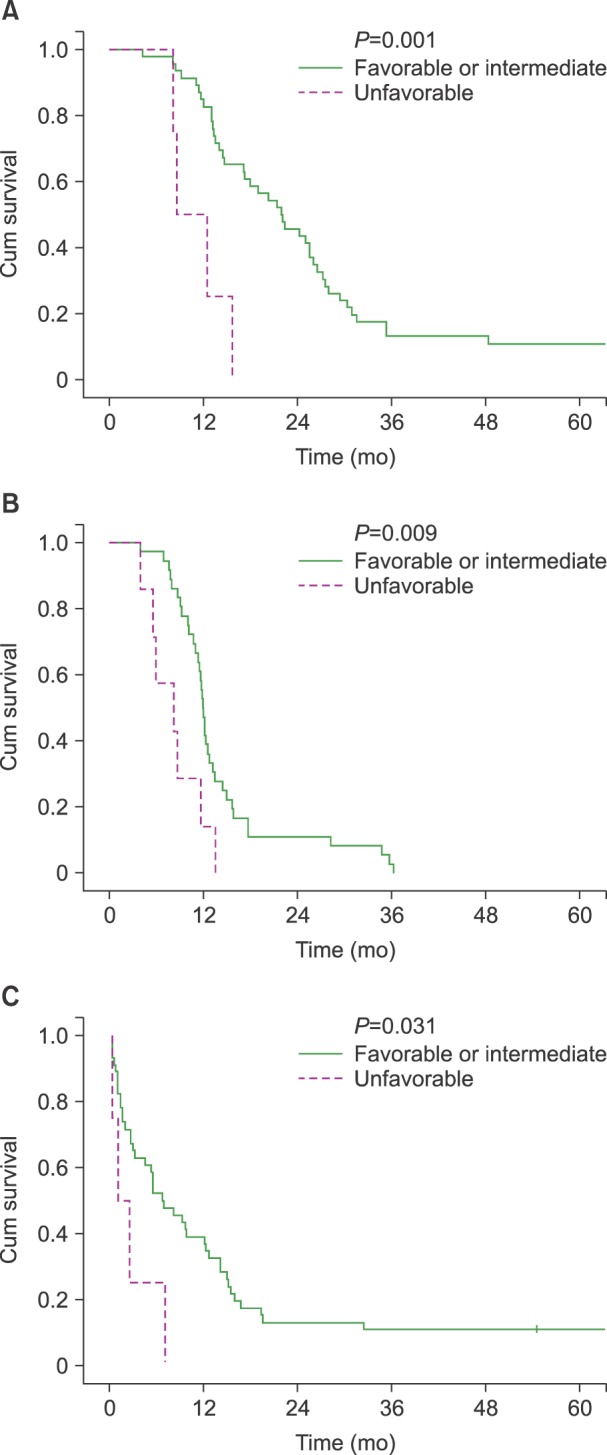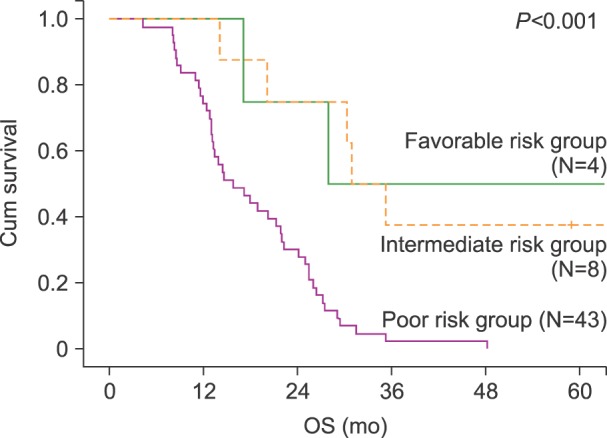Blood Res.
2016 Sep;51(3):175-180. 10.5045/br.2016.51.3.175.
Evaluation of prognostic factors in patients with relapsed AML: Clonal evolution versus residual disease
- Affiliations
-
- 1Department of Hematology-Oncology, Pusan National University Hospital, School of Medicine, Pusan National University, Busan, Korea. hemon@pusan.ac.kr
- 2Department of Laboratory Medicine, Pusan National University Hospital, School of Medicine, Pusan National University, Busan, Korea.
- KMID: 2353498
- DOI: http://doi.org/10.5045/br.2016.51.3.175
Abstract
- BACKGROUND
It is widely known that the prognosis of acute myeloid leukemia (AML) depends on chromosomal abnormalities. The majority of AML patients relapse and experience a dismal disease course despite initial remission.
METHODS
We reviewed the medical records and laboratory findings of 55 AML patients who had relapsed between 2004 and 2013 and who had been treated at the Division of Hematology of the Pusan National University Hospital.
RESULTS
The event-free survival (EFS) was related to prognostic karyotype classification at the time of diagnosis and relapse (unfavorable vs. favorable or intermediate karyotypes at diagnosis, 8.2 vs. 11.9 mo, P=0.003; unfavorable vs. favorable or intermediate karyotypes at relapse, 8.2 vs. 11.9 mo, P=0.009). The overall survival (OS) was significantly correlated with karyotype classification only at diagnosis (unfavorable vs. favorable or intermediate vs. karyotypes at diagnosis, 8.5 vs. 21.8 mo, P=0.001; unfavorable vs. favorable or intermediate karyotypes at relapse, 8.5 vs. 21.2 mo, P=0.136). A change in karyotype between diagnosis and relapse, which is regarded as a factor of resistance against treatment, was not a significant prognostic factor for OS, EFS, and post-relapse survival (PRS). A Cox proportional hazards model showed that the combined use of fludarabine, cytosine arabinoside, and granulocyte colony-stimulating factor (FLAG) as a salvage regimen, was a significant prognostic factor for OS (hazard ratio=0.399, P=0.010) and the PRS (hazard ratio=0.447, P=0.031).
CONCLUSION
The karyotype classification at diagnosis predicts survival including PRS in relapsed AML patients as well as in treatment-naïve patients. We suggest that presently, administration of salvage FLAG could be a better treatment option.
Keyword
MeSH Terms
Figure
Reference
-
1. Bishop JF. The treatment of adult acute myeloid leukemia. Semin Oncol. 1997; 24:57–69. PMID: 9045305.2. Döhner H, Estey EH, Amadori S, et al. Diagnosis and management of acute myeloid leukemia in adults: recommendations from an international expert panel, on behalf of the European Leukemia-Net. Blood. 2010; 115:453–474. PMID: 19880497.
Article3. Craddock C, Tauro S, Moss P, Grimwade D. Biology and management of relapsed acute myeloid leukaemia. Br J Haematol. 2005; 129:18–34. PMID: 15801952.
Article4. Weltermann A, Fonatsch C, Haas OA, et al. Impact of cytogenetics on the prognosis of adults with de novo AML in first relapse. Leukemia. 2004; 18:293–302. PMID: 14671635.
Article5. Breems DA, Van Putten WL, Huijgens PC, et al. Prognostic index for adult patients with acute myeloid leukemia in first relapse. J Clin Oncol. 2005; 23:1969–1978. PMID: 15632409.
Article6. Estey E, Keating MJ, Pierce S, Stass S. Change in karyotype between diagnosis and first relapse in acute myelogenous leukemia. Leukemia. 1995; 9:972–976. PMID: 7596187.7. Garson OM, Hagemeijer A, Sakurai M, et al. Cytogenetic studies of 103 patients with acute myelogenous leukemia in relapse. Cancer Genet Cytogenet. 1989; 40:187–202. PMID: 2766243.
Article8. Testa JR, Mintz U, Rowley JD, Vardiman JW, Golomb HM. Evolution of karyotypes in acute nonlymphocytic leukemia. Cancer Res. 1979; 39:3619–3627. PMID: 476688.9. Ding L, Ley TJ, Larson DE, et al. Clonal evolution in relapsed acute myeloid leukaemia revealed by whole-genome sequencing. Nature. 2012; 481:506–510. PMID: 22237025.10. Kern W, Haferlach T, Schnittger S, Ludwig WD, Hiddemann W, Schoch C. Karyotype instability between diagnosis and relapse in 117 patients with acute myeloid leukemia: implications for resistance against therapy. Leukemia. 2002; 16:2084–2091. PMID: 12357361.
Article11. Kim Y, Jang J, Hyun SY, et al. Karyotypic change between diagnosis and relapse as a predictor of salvage therapy outcome in AML patients. Blood Res. 2013; 48:24–30. PMID: 23589791.
Article12. Yates J, Glidewell O, Wiernik P, et al. Cytosine arabinoside with daunorubicin or adriamycin for therapy of acute myelocytic leukemia: a CALGB study. Blood. 1982; 60:454–462. PMID: 6953986.
Article13. Chucrallah AE, Stass SA, Huh YO, Albitar M, Kantarjian HM. Adult acute lymphoblastic leukemia at relapse. Cytogenetic, immunophenotypic, and molecular changes. Cancer. 1995; 76:985–991. PMID: 8625224.
Article14. Vora AJ, Potter AM, Anderson LM, Lilleyman JS. Frequency and importance of change in blast cell karyotype in relapsing childhood lymphoblastic leukemia. Pediatr Hematol Oncol. 1994; 11:379–386. PMID: 7947010.
Article
- Full Text Links
- Actions
-
Cited
- CITED
-
- Close
- Share
- Similar articles
-
- Serial Determination of FLT3-ITD and NPM1 Mutations and Its Clinical Significance in Patients with MDS at Diagnosis and After Progression to AML with Myelodysplasia-related Changes
- Karyotypic change between diagnosis and relapse as a predictor of salvage therapy outcome in AML patients
- Outcome of Intensive Therapy for Children with Relapsed Acute Myeloid Leukemia: A Single Institution Korean Study
- Evaluation of prognostic factors in patients with therapy-related acute myeloid leukemia
- Prevalence and Clinical Significance of p15 Methylation in Acute Leukemia



